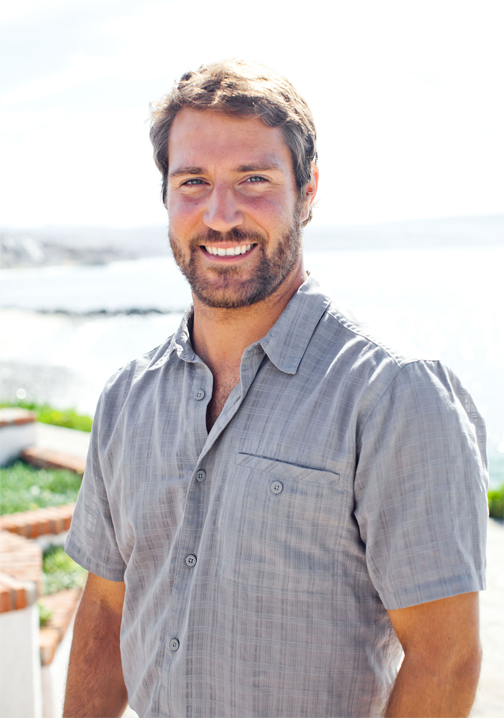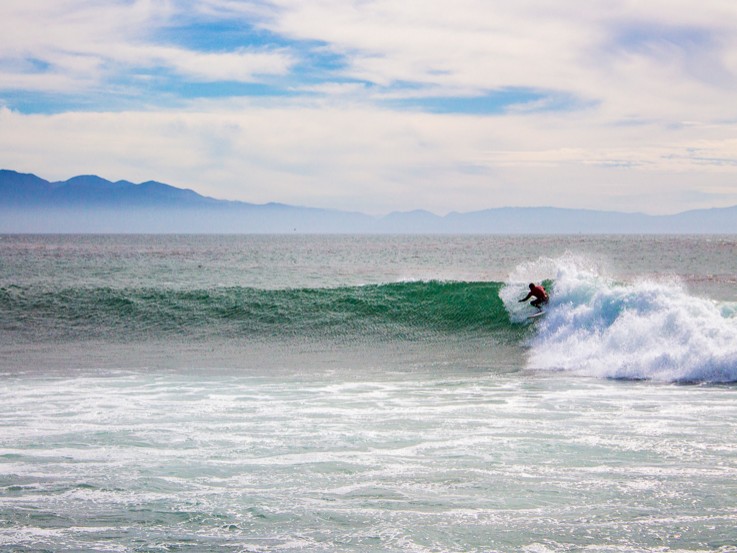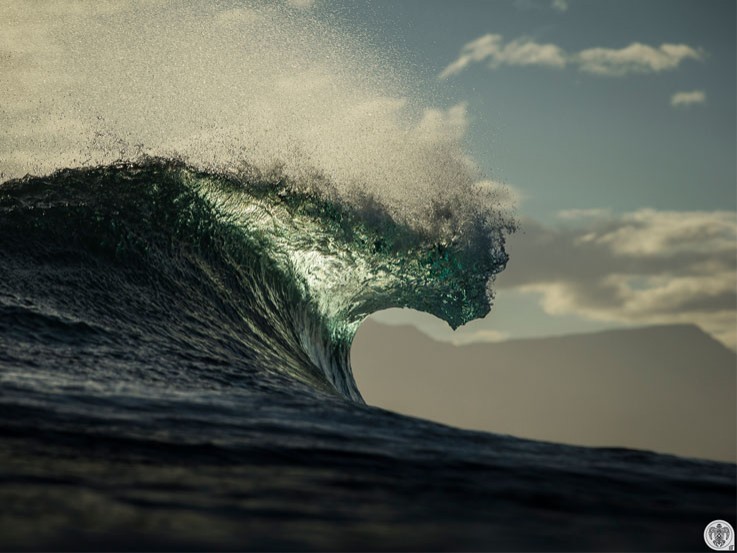Nik Strong-Cvetich - Save The Waves
We talk to Nik Strong-Cvetich (pronounced "strong-suh-vetich"). He has 7 years of experience leading innovative conservation projects under his belt. He is passionate about the ocean, the surf and the coastal protection. Throughout his career, he has founded trainning programs in conservation project management, worked as a consultant in ecotourism development in coastal communities worldwide, and built innovative programs focused on water resource issues.

Tell us a bit about you.
I am cancer and I like long walks on the beach….
What is your education?
I have a BA in International Affairs, and a Masters in Public Administration and Environmental Policy (basically environmental non-profit management).
What is that you love about the ocean?
The thing I love most about the ocean is that it is sort of the last great wilderness in many respects. The quantity of cool big animals we see on a day to day basis here in Santa Cruz is only rivalled on land by the Serengeti. I love that the ocean challenges you constantly. It's a place that both freaks you out and at the same time calms you down. Plus it has surfing, which I love.
What is your current job and how did you started working there?
I am the Executive Director for Save The Waves Coalition. I first got the job thanks to my friend Kyle Thiermann who was a long time ambassador for STW. We would hang out and I’d help him brainstorm on different projects, until one day the job opened up and he said “you should really consider this”. So I did, and three and a half years later here we are.
What inspired you to do the job you do?
I think earliest, my dad was a fisherman and we lived on a small island. So when I was really small wild coastlines basically surrounded my youth. Then later traveling to surf and visiting a really cool place only to come back a few years later to see it completely wrecked. I think what ultimately motivates me is that I am passionate about coastal conservation and I am passionate about surfing, and that combining the two helps us protect both. I worked for many water quality issues over the years, and found that mostly people just don’t care.
When you get the surf community in a place involved in a water quality issue, they sure as hell care, because it impacts them directly.
I find the thing that motivates me most is when you can assemble a group of people who care, and can find a proactive solution to an environmental problem. You get stoked! This is what Save The Waves has that motivates me.
How did you get involved in Save the Waves?
Again, I was always familiar with Save The Waves’ unique approach, especially using surfonomics to make an economic argument for protections of the coasts. Plus, the World Surfing Reserves program. I thought was a great alternative type of protected area, so I was paying attention for a long while. Then when the job as ED opened up, I felt like it united all the disparate parts of my background. I surfed, had always worked in conservation, always travelled, spoke a few languages, worked on a few documentary projects, and had a real passion for creative entrepreneur projects. STW basically united all of those different areas in to one awesome job.

Save The Waves Team
Do you have any previous experience in the surf / environmental industry?
I never worked in the surf industry, but I got involved in some weird skateboarding projects in Africa a long time ago. With regards to environmental experience- tons. In the past ten years, I’ve launched a training program for aspiring conservation leaders, built and taught environmental education programs around watersheds, passed water quality legislation in Santa Cruz, worked with farmers on water quality improvement projects, and helped solve drought issues at the community level with some pretty innovative economic incentive and technology schemes.
How does your daily schedule look like working for an organisation like Save the Waves?
I generally wake up pretty early and make sure there are no fires to put out on email. Being that we work in Chile, Mexico, Peru, Europe and Australia, there are so many timezones, that there is really not that much down time. I try to either surf or tackle one big project for the day before I head to the office by 9am. I check in with the team generally, and then always try to schedule my meetings at 10am and 2pm, this means I don’t really have to remember when I’ve scheduled something because it is like the steering wheel schedule: 10 and 2 - easy to remember and keep free. Usually someone sneaks in there with another meeting in between though, so not sure how effective it is. I spend the rest of the day, tackling issues with the team, whether it be a program related issue, or a press release that needs to go out, or a newsletter or change to the website, or budgeting question. Generally, by 5:30 pm everyone is gone and I get a few minutes to finish my last big task for the day in silence and plan the next day. Then if lucky I’ll get a sunset surf, which is my favourite time.
What are the biggest barriers that Save The Waves has encountered on its way?
The three biggest hurdles are having enough resources to do what we want, not having enough staff on the ground where we work, and local politics. As a non-profit there are never enough resources. Unlike a business that can sell more widgets and has a predictable demand for the product, we have to constantly be adapting how we do fundraising and what we can do with what we have.
I would say I am super proud of what we pull off with sheer creativity—people are pretty amazed at the projects we have considering our size.
Second, I think we’d have a much easier time overcoming some of the hurdles with more localized staff. We have an amazing manager on the ground in Baja – Mara Rodriguez – who is able to get some much done. The more local folks we have on our team, the better the outcome—always. Last, we are often at the whim of political winds in these places which is out of our control. For example, one of our projects in Bali was on track to be amazing, but the local government decided to throw away years of Marine Spatial Planning to then build an artificial set of islands at Benoa harbour, and wreck some pretty cool coastline. Those types of battles are hard to fight and have to carefully picked. I can name a dozen times where local politics change and the whole approach needs to be adapted.
Do you think the new generations are more educated about the importance of the coastal protection?
Yes and no. I think people are more informed about the issues in many places, but we are also much more disconnected from the coast as well. Overall though, I am hopeful that we see more and more kids caring about their coasts and getting involved.
Any big projects/plans for “Save the Waves” coming soon?
Yes! We are on track to have a few things we’ve been working on come to fruition. We should see the wave and river at San Miguel in Baja officially protected as Baja’s first state park before the end of the year, you can check out more here at www.savethewaves.org/savesanmiguel. Plus, we are getting closer to the goal of acquiring and protecting the first and most important parcel of land at Punta de Lobos. If people want to get involved they can check out www.lobosporsiempre.org. Last, we’re trying to build an app for surfer to act as a crowdsource of data on water quality, trash and access issues all over the world.
Where can we find you online?
| Website | www.savethewaves.org |
| www.facebook.com/savethewavescoalition | |
| https://twitter.com/savethewaves | |
| www.instagram.com/stwcoalition/ | |
| www.linkedin.com/company/save-the-waves-coalition |
Posted by: Marta Gallardo, on April 11, 2016
Categories: Interviews
Latest Posts
Craig Sims - White Horses & Surfing Life Publisher
Luke Kennedy - Editor of Tracks Magazine
Simon ‘Swilly’ Williams - Surf Photographer
Jarra Campbell - the Bondi Alchemist
Greg Gordon - Owner of CR Surf
Shayne Nienaber - Surf Photographer
Alexa Hohenberg - Owner of Still Stoked
Christine Deveney - TapaReef Owner & Creator
Russell Ord - Surf Photographer
Richard Kotch - Surf Photographer
Categories
Interviews
Articles
Videos
Press Releases
Quiz
Archive
December 2018
November 2018
October 2018
September 2018
August 2018
July 2018
June 2018
May 2018
April 2018
March 2018
February 2018
January 2018
November 2017
January 2017
December 2016
November 2016
October 2016
September 2016
August 2016
July 2016
June 2016
May 2016
April 2016
March 2016
February 2016
January 2016
December 2015
November 2015
October 2015
September 2015
August 2015
July 2015
June 2015
May 2015
April 2015
March 2015
February 2015
January 2015
December 2014
November 2014
October 2014
September 2014
August 2014
July 2014
June 2014
May 2014
April 2014
March 2014
February 2014
January 2014
December 2013
November 2013
October 2013
September 2013
August 2013
July 2013
June 2013
May 2013
April 2013
March 2013










